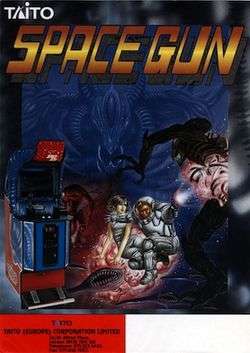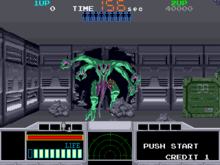Space Gun (video game)
| Space Gun | |
|---|---|
 The arcade flyer depicts the protagonist shooting an alien. | |
| Developer(s) | Taito |
| Publisher(s) | Taito |
| Composer(s) |
Norihiro Furukawa Naoto Yagishita |
| Platform(s) | |
| Release date(s) | |
| Genre(s) | Shooting gallery |
| Mode(s) | Single-player, Multiplayer |
| Cabinet | Upright |
| Display | Raster, 320 x 240 pixels (Horizontal), 4096 colors |
Space Gun (スペースガン Supēsu Gan) is a first-person, shoot 'em up arcade game released by Taito in 1990. It was later distributed for various home games consoles in 1992, and in 2005, it was included as part of the compilation Taito Legends on the PlayStation 2, PC and Xbox. It is set aboard a crippled space station that has been overrun by hostile alien creatures; there are human crew members that the player must attempt to rescue while destroying the alien creatures. Space Gun features simulated gore, giving the player the ability to shoot limbs off the creatures while blood splatters appear on screen. Various weapon upgrades can be found during gameplay. The music from the game is featured on several commercially released compact discs. It was fairly well received by critics both in arcades and when released for home systems. It was one of only a few games that supported a light gun peripheral for some of the home systems releases.
Gameplay

The game is set in a fictional future, in the year 2039, where humans have begun deep space exploration. A distress call is transmitted from a crippled ship near an alien planet. The game's protagonist, a special soldier, responds to the call. Upon boarding the ship, the soldier discovers it has been overrun by hostile aliens. The aliens have captured the human crew for an unknown purpose. The story has sections that take place aboard the space craft and on the planet's surface. The protagonist's overall goal is to rescue as many human hostages as possible, eliminate the alien threat, and escape the space craft.[7]
Space Gun is an Arcade Rail Shooter in which the player views the on-screen action from a first person perspective. Players use a cabinet mounted light gun to target and shoot enemies. Enemies are either mechanical guns that descend from above the screen or aliens,[8] several of which can only be defeated by first shooting away their limbs.[9] The player must save human hostages from the creatures.[10] Occasionally, a hostage will mutate into an alien.[11] In addition to the standard rapid fire weapon, there are four other weapons: a flamethrower, grenade launcher, freeze bomb, and blade bomb.[12] These weapons require ammunition which can be collected throughout the stages, and are activated by the player using the pump action of the mounted gun. The arcade cabinet features foot pedals (visible in picture) that, when pressed, reverse the player's direction. This is an essential feature, as it allows the player more time to fire upon an incoming enemy and to also help keep the number of enemies at a more manageable level and thereby keep from being overwhelmed. It also adds an element of strategy to the game, as over-use of the "backpedal" runs the risk of running out of time on the level.
There are six or seven levels (depending on which version of the game is being played) that are split into four subsections, each with its own end-of-level boss.[13][14] Between levels the story is explained and moved forward through the use of short animated cut-scenes[15] with text on the screen. Players can often choose their own path through the level by selecting a door or arrow using the gun.[8] Several of the home system versions feature light gun support; however, all of them allow the player to move a crosshair to target enemies. The multiplayer game is identical to the single-player experience,[12] but the Sega Master System, Commodore 64 and ZX Spectrum versions do not feature multiplayer.[16][17]
Development and history
The arcade game features raster graphics on a CRT monitor displaying 4096 colors and amplified stereophonic sound. The visuals are reflected into view via a mirror in the cabinet.[1] The arcade cabinet is upright, with the marquee bearing the game's name protruding outward. There are large, blue plastic molds around the cabinet designed to resemble an alien cocoon.[1] The music for Space Gun was composed by Norihiro Furukawa and Naoto Yagishita of Zuntata, Taito's music division. A soundtrack CD (a split release with the soundtrack for Taito game Liquid Kids) was released by Pony Canyon and Scitron on January 21, 1991.[18][19] This album was also released as part of Taito 1500 Collector's Box on September 17, 1993.[20] A track from the game is on the limited edition CD Zuntata History L'ab-normal 1st, released by Zuntata/Taito on April 1, 1999.[21]
Home conversions
In 1992, Ocean Software ported the game to home gaming systems, including the Amiga, Atari ST, Commodore 64 and ZX Spectrum.[22] Due to the hardware limitations of the various systems, the graphics and sounds of the ports differ from the original arcade version; for example, the ZX Spectrum version did not allow the aliens' limbs to be shot off.[23] Some home versions use a light gun peripheral to simulate the control scheme of the arcade format. The Sega Master System port uses the Sega Light Phaser accessory. The Amiga and Atari ST versions are one of the few games to use the Trojan Light Gun.[2][3] In developing the Amiga conversion, the team video taped the arcade machine in operation as a reference for the graphics, pausing the video at relevant spots to take notes before recreating them.[24] Programmer Damien Stones spent four months on the ZX Spectrum version. He kept the graphical detail of the backgrounds simple to allow for more action in the foreground. Taking into account the system's lower capabilities compared to the arcade hardware, Stones designed the game to handle a large number of on-screen sprites. As a result, Space Gun becomes more efficient the more action occurs on the screen, but will slow down during lulls in the game.[25] In 2005, Space Gun was included in the compilation title Taito Legends for the PlayStation 2, personal computer and Xbox.[4][5][6]
Reception
| Space Gun | ||||||||||||||||||||
|---|---|---|---|---|---|---|---|---|---|---|---|---|---|---|---|---|---|---|---|---|
| ||||||||||||||||||||
Space Gun was well received by the video game press. In issue 34 of Zero, Amaya Lopex gave the original arcade version of the game four out of five stars.[26] Jonnie Cook of Sinclair User described the arcade release as enjoyable to those that already liked the genre, but stated he preferred other games.[30] Killer List of Videogames called the cabinet design "quite unique".[1] In March 1992, Gary Whitta of Advanced Computer Entertainment magazine stated that the sections that scroll into the screen are a lot easier to play than the horizontally scrolling sections.[8] The screen can quickly fill up with enemies, which can lead to confusion as to what the player is shooting at,[10][31] especially when human hostages run across the screen as they can be inadvertently killed. Neil West of Amiga Format commented that the title has a high difficulty level and that power-ups are a necessity to continue playing.[12] The "not perfect" rapid fire weapon (which needs recharging after prolonged use) contributes to the game's difficulty, as stated by Brian Sharp of Games-X magazine.[32]
Several publications compared the game's plot to that of the 1979 film Alien.[8][11][15] Simon Forrester of Your Sinclair jokingly referred to Space Gun as the "unofficial game" of the film.[15] Zero magazine gave particular praise to the sections where humans mutate into aliens as they run towards the player.[11] Your Sinclair reviewer Jon Pillar and Chris Buffa of GameDaily said that Space Gun contains graphic violence, citing the visual effect of entrails and blood splashed against the screen.[33][34] Steve Merritt of CU Amiga described the sound effects, specifically alien squeals and the pumping heartbeat, as "simple, but effective".[9]
On release for home platforms, the game received mixed reviews in the press, ranging from 69% in Amiga Format[12] to 84% in CU Amiga magazine.[9] A preview from Amiga Power described Space Gun as deriving from an "inexplicably popular coin-op, best described as Line of Fire set in space."[35] Several reviews have stated that Space Gun is an Operation Wolf clone,[10][28] while it has also been compared unfavorably to Operation Thunderbolt.[8] Sega Power magazine reviewed the Master System version, giving the game a score of 70% if the player is using a Light Phaser, but only 50% if a control pad is being used.[16] Paul Presley of The One for Amiga Games also found that using input devices other that the guns mounted to the arcade machine "just isn't the same".[36] Prior to the release for the Xbox and PS2 as part of Taito Legends the game was regarded by Gamedaily as being in the "top five" of the games in the collection,[34] and on release the same website described it as "thoroughly enjoyable".[37]
References
- 1 2 3 4 "Space Gun – Videogame by Taito (1990)". Killer List of Video Games. Retrieved 2009-09-20.
- 1 2 "Space Gun – Moby Games". Moby Games. Retrieved 2009-08-21.
- 1 2 "IGN: Space Gun". IGN. Retrieved 2009-10-25.
- 1 2 "Taito Legends for PS2". GameSpot. Retrieved 2009-10-25.
- 1 2 "Taito Legends for Xbox". GameSpot. Retrieved 2009-10-25.
- 1 2 "Taito Legends for PC". GameSpot. Retrieved 2009-10-25.
- ↑ Space Gun manual (ZX Spectrum release ed.). Ocean Software. 1992.
- 1 2 3 4 5 6 Whitta, Gary (March 1992). "Space Gun". Advanced Computer Entertainment. EMAP (54): 31.
- 1 2 3 4 Merrit, Steve (January 1992). "Space Gun". CU Amiga. EMAP: 81–82.
- 1 2 3 4 Smith, Tim (June 1992). "Space Gun". MegaZone (22): 40.
- 1 2 3 Wilson, David (February 1991). "Space Gun". Zero. Dennis Publishing: 53.
- 1 2 3 4 5 West, Neil (May 1992). "Space Gun". Amiga Format. Future Publishing (34): 64.
- ↑ Sega Master System version back cover
- ↑ "Space Gun". Crash. Newsfield Publications (96): 52.
- 1 2 3 Forrester, Simon (May 1993). "Space Gun Review". Your Sinclair. Dennis Publishing (89): 40.
- 1 2 "Space Gun". Sega Power. Future Publishing (38). January 1993.
- ↑ "Space Gun tech info". Moby Games. Retrieved 2009-10-20.
- ↑ ゲーム・ミュージック-リリース-スペースガン・ミズバク大冒険 (in Japanese). Oricon. Retrieved 2009-10-22.
- ↑ アルバムラインアップ (in Japanese). Taito Corporation. Retrieved 2009-10-22.
- ↑ ゲーム・ミュージック-リリース-タイトー1500コレクターズBOX (in Japanese). Oricon. Retrieved 2009-10-22.
- ↑ "ZTTL-0038 Zuntata History L'ab-normal 1st" (in Japanese). Taito Corporation. Retrieved 2009-10-20.
- ↑ "Space Gun release info". Moby Games. Retrieved 2009-10-15.
- ↑ King, P. (March 1992). "Space Gun". Zzap!64. Newsfield Publications (82): 52.
- ↑ "Space Gun Amiga conversion information". Hall of Light – the database of Amiga games. Retrieved 2009-08-17.
- ↑ Hickman, Lucy (December 1991). "Space Gun preview". Crash. Newsfield Publications (94): 18.
- 1 2 Lopex, Amaya (August 1992). "Space Gun '92". Zero. Dennis Publishing (34): 80.
- ↑ Lakin, Paul (May 1992). "Space Gun". Zero. Dennis Publishing (31): 48.
- 1 2 Lee, Peter (March 1992). "Space Gun". Amiga Action (30): 40–41.
- ↑ Ramshaw, Mark (April 1992). "Space Gun". Amiga Power. Future Publishing (12): 77–78.
- ↑ Cook, Jonnie (February 1991). "Space Gun – Taito". Sinclair User. EMAP.
- ↑ "Space Gun". Sinclair User. EMAP (120): 19.
- ↑ Sharp, Brian (January 1992). "Space Gun". Games-X (39): 11.
- ↑ Pillar, Jon (April 1992). "Space Gun". Your Sinclair. Dennis Publishing (76): 19.
- 1 2 Buffa, Chris. "Taito Legends on Xbox previews". GameDaily. Retrieved 2009-10-25.
- ↑ "Space Gun preview". Amiga Power. Future Publishing (10). February 1992.
- ↑ Presley, Paul (April 1992). "Space Gun". The One for Amiga Games (43): 48–49.
- ↑ Workman, Robert. "Taito Legends on Xbox reviews". GameDaily. Retrieved 2009-10-25.
External links